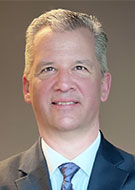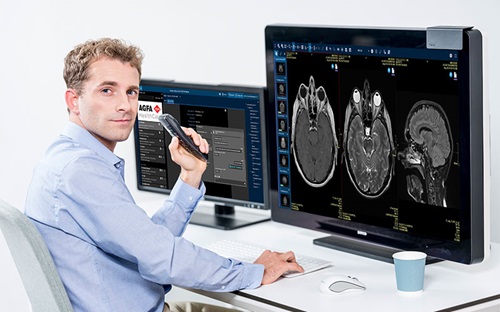Smart Solutions for Tackling Radiologist Burnout, Boosting Efficiency
AGFA HealthCare empowers radiologists with innovative tools which help to reduce stress, streamline workflows and create greater focus on patient care


RSNA News presents this sponsored Industry Focus article.
Rising imaging demand, complex scans and workforce shortages are fueling the burnout crisis among radiologists. To ease these pressures, innovative technology is reshaping enterprise imaging workflows to optimize daily practice and help tackle inefficiencies that lead to substandard patient care.
AGFA HealthCare is at the forefront, integrating workflow orchestration, AI-driven automation and cloud technology to help radiologists regain excellence in patient care.
“Radiologists don’t enter the field to just sit in a dark room reading scans,” said Kyle Souligne, enterprise imaging for radiology marketing director at AGFA HealthCare. “We want to reconnect them to the thing that brought them to medicine in the first place—patient care.”
With an ever-increasing number of patients requiring imaging as part of their care, radiologists are inundated with more images per study, additional electronic health record (EHR) data, and AI-generated insights, which create a challenging work environment.
AGFA HealthCare recognizes that in order for radiologists to meet these challenges effectively, solutions must be embedded into a streamlined workflow.
“It’s one thing to just provide tools, but if those tools aren’t interconnected into an optimized workflow, then they’re just tools,” Souligne said. “Simply adding more technology isn’t the solution; instead, technology should be used strategically to reduce cognitive burden and help radiologists find fulfillment in their work.”
“Simply adding more technology isn’t the solution; instead, technology should be used strategically to reduce cognitive burden and help radiologists find fulfillment in their work.”
– KYLE SOULIGNE
Intelligent Workflow, AI-Powered Automation and Cloud Integration
AGFA HealthCare’s Enterprise Imaging Platform leverages workflow orchestration to balance case distribution. “For example, intelligent worklists assign cases based on the customer’s preferences and priorities, such as expertise, workload balance and minimizing cognitive strain—promoting efficiency without forcing radiologists to do more,” said Rob Mayer, AGFA HealthCare’s chief product officer.
The platform also can prioritize urgent cases, whether flagged by study findings, relevant service level agreements or some other established rule. “By automating this process, the system prevents a chaotic or reactive environment and intelligently routes these cases to an appropriate qualified radiologist,” Mayer said. “Urgent cases can integrate seamlessly into the workflow as priorities while still allowing radiologists to manage their regular workload efficiently.”
Enterprise Imaging Cloud adds another layer of efficiency, enabling radiologists to securely access imaging studies from anywhere without requiring massive data transfers. This seam[1]less remote work capability enhances flexibility while reducing the logistical challenge of managing imaging studies across multiple locations.
“Cloud adoption isn’t an all-or-nothing decision, and organizations have varying needs, such as using the cloud for storage or disaster recovery,” Mayer said.
To meet these diverse needs, AGFA provides flexible cloud service options, allowing organizations to adopt the right level of cloud integration to suit their needs, without unnecessary additions to their existing environment.
Strategic AI Implementation for Long-Term Value
While AI holds great promise, its implementation in radiology must be strategic to drive real-world productivity gains. Before adopting AI tools, customers should first identify their primary challenges—clinical, productivity or financial.
Mayer and Souligne noted that any AI tool’s long-term success depends on measurable improvements in efficiency, accuracy, return on investment, and more recently, clinical satisfaction.
AGFA HealthCare embeds AI-driven insights directly into workflows, optimizing decision-making and automating many manual tasks. This integration helps radiologists efficiently navigate complex datasets without feeling overwhelmed.
“The focus should be on ensuring enterprise imaging vendors provide integrated, first-party solutions, or those that function that way,” Mayer said. “It should not be a collection of disparate systems but rather a unified, strategic enterprise imaging approach.”
“AI tools should feel like a natural extension of a radiologist’s workflow—not an extra burden,” Souligne added. “Our goal is to integrate AI-driven insights in a way that makes decision[1]making easier, not more complicated.”
AI-driven decision support also is expected to deliver small but impactful time savings by cutting seconds per study. “Over thousands of cases, these incremental improvements lead to significant efficiency gains,” Mayer said.

A Standards-Based Approach
AGFA HealthCare has long championed the development and implementation of industry standards, going beyond DICOM support to drive true interoperability. By adhering to industry standards such as Integrating the Healthcare Enterprise (IHE) and FHIRcast, AGFA eliminates unnecessary friction in daily tasks by supporting seamless integration with EHRs, clinical systems and third-party AI tools.
“We’re the first company to enable the IHE Integrated Reporting Applications profile and to obtain the IHE Connectathon SEAL for the profile,” Mayer said.
Through strategic partnerships with specialized solutions providers, they further enhance reporting efficiency by automating the population of key findings into reports, cutting back manual data entry and reducing errors.
Meanwhile, FHIRcast-based integration keeps everything in sync, minimizing interruptions and speeding up decision-making.
Keeping Radiologists in the Flow
When it comes to navigating the traditional bottleneck of managing prior comparison exams, AGFA HealthCare’s pixel streaming technology helps eliminate this inefficiency.
According to Souligne, Enterprise Imaging Platform’s rules-based engine selects relevant prior studies for comparison, and intelligent hanging protocols display them, reducing the need to pull entire patient histories manually. This is particularly beneficial for facilitating remote work.
“Instead of downloading full studies, the system renders them on the server and streams only the necessary pixels, significantly reducing wait times,” Souligne said. “The platform intelligently identifies the most relevant prior exams for comparison and renders them server-side, minimizing interruptions. In this way, no matter where the radiologists are, they stay in the flow.”
AGFA HealthCare’s innovative solutions streamline workflows to maintain focus on what matters the most, patient care. By enhancing efficiency and reducing stress, AGFA helps radiologists regain control of their workday and deliver high-quality care, ultimately reducing the risk of burnout in this vital health care profession.
RSNA News presents this sponsored Industry Focus article.
Excellence Achieved
In 2025 AGFA HealthCare proudly celebrates multiple KLAS distinctions securing two #1 Best in KLAS awards for XERO® Viewer and VNA, alongside the KLAS Most Improved Software Product award. Additionally, AGFA HealthCare earned exceptional ratings in PACS radiology and cardiology reviews. These prestigious recognitions affirm AGFA HealthCare’s unwavering commitment to innovation and customer success.